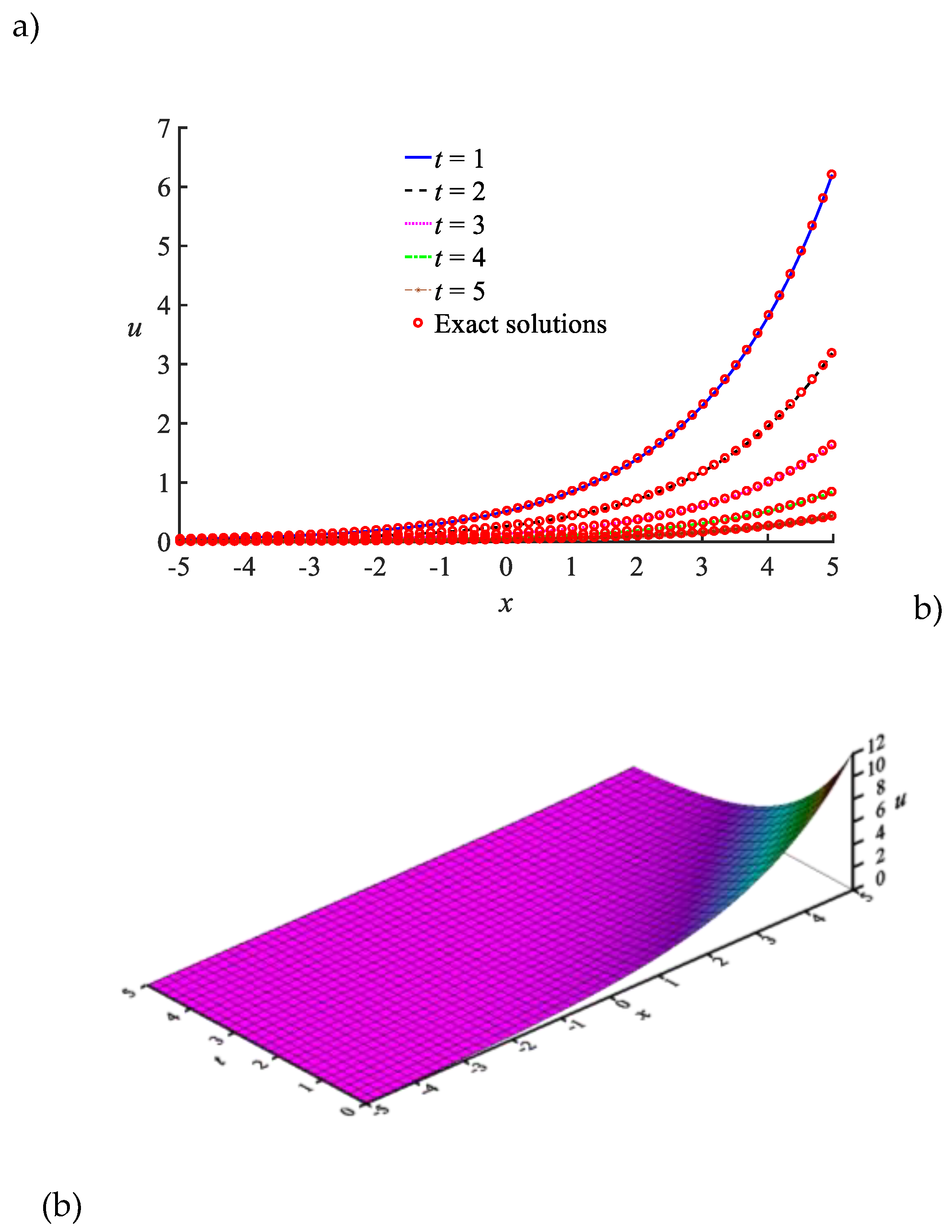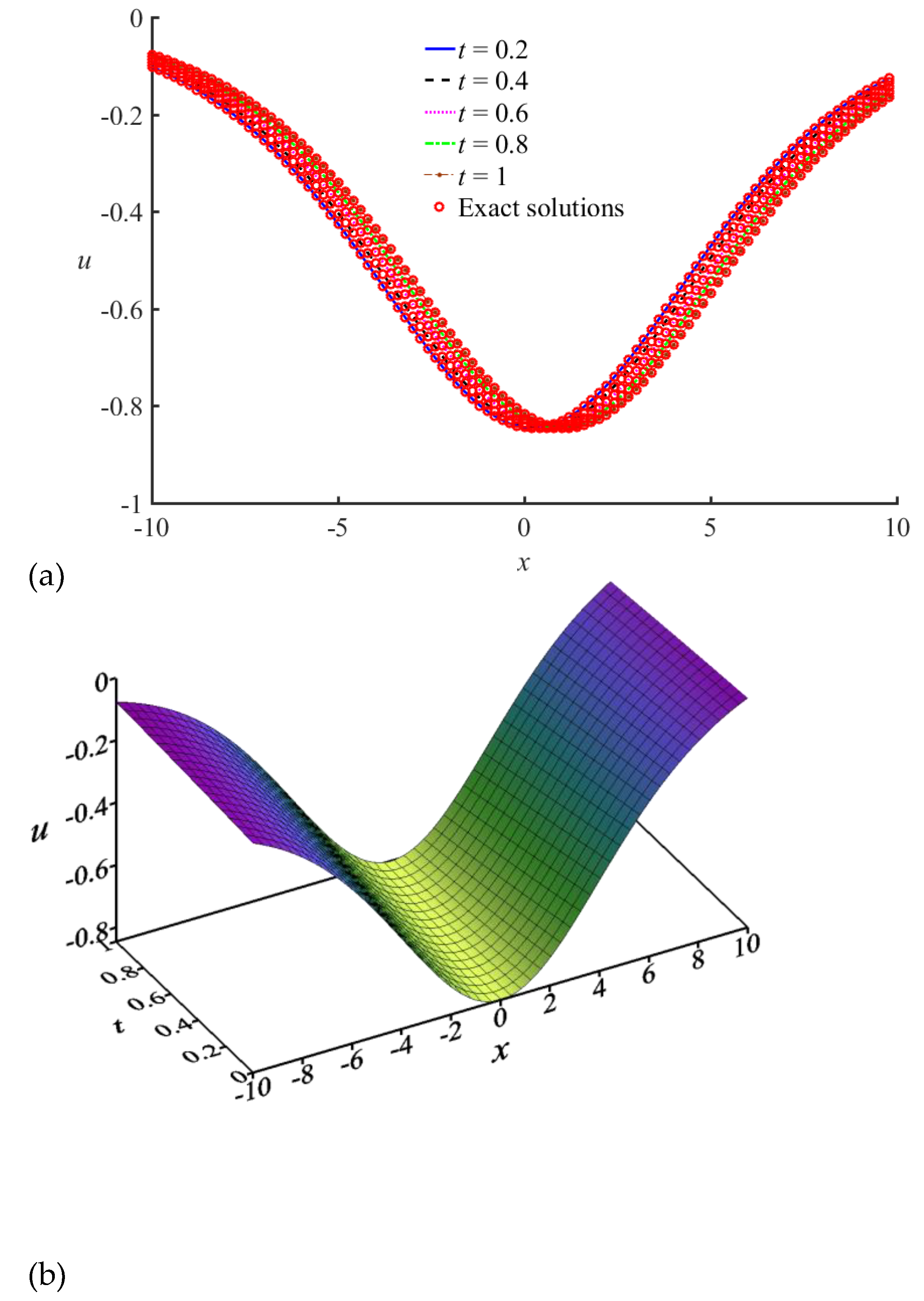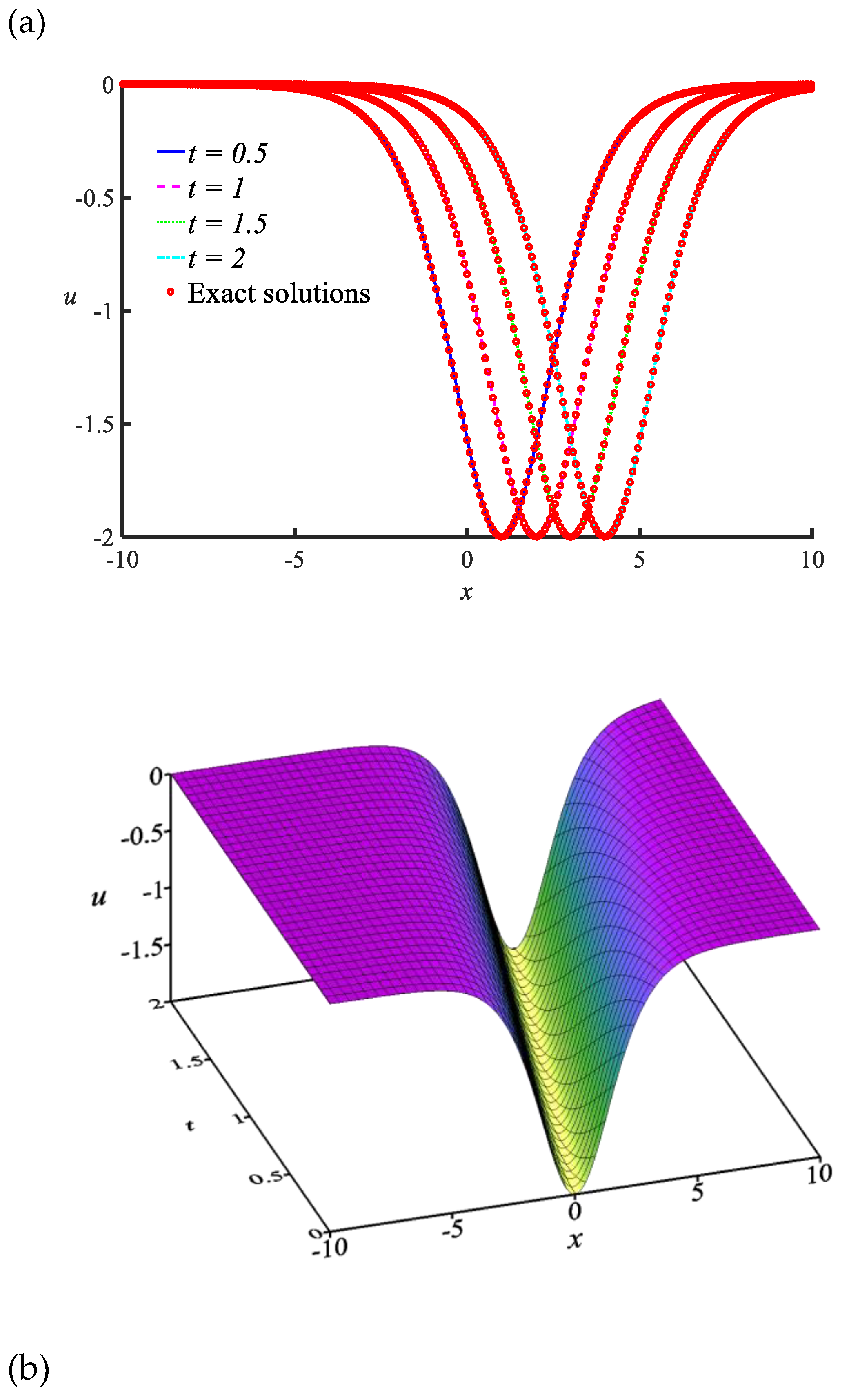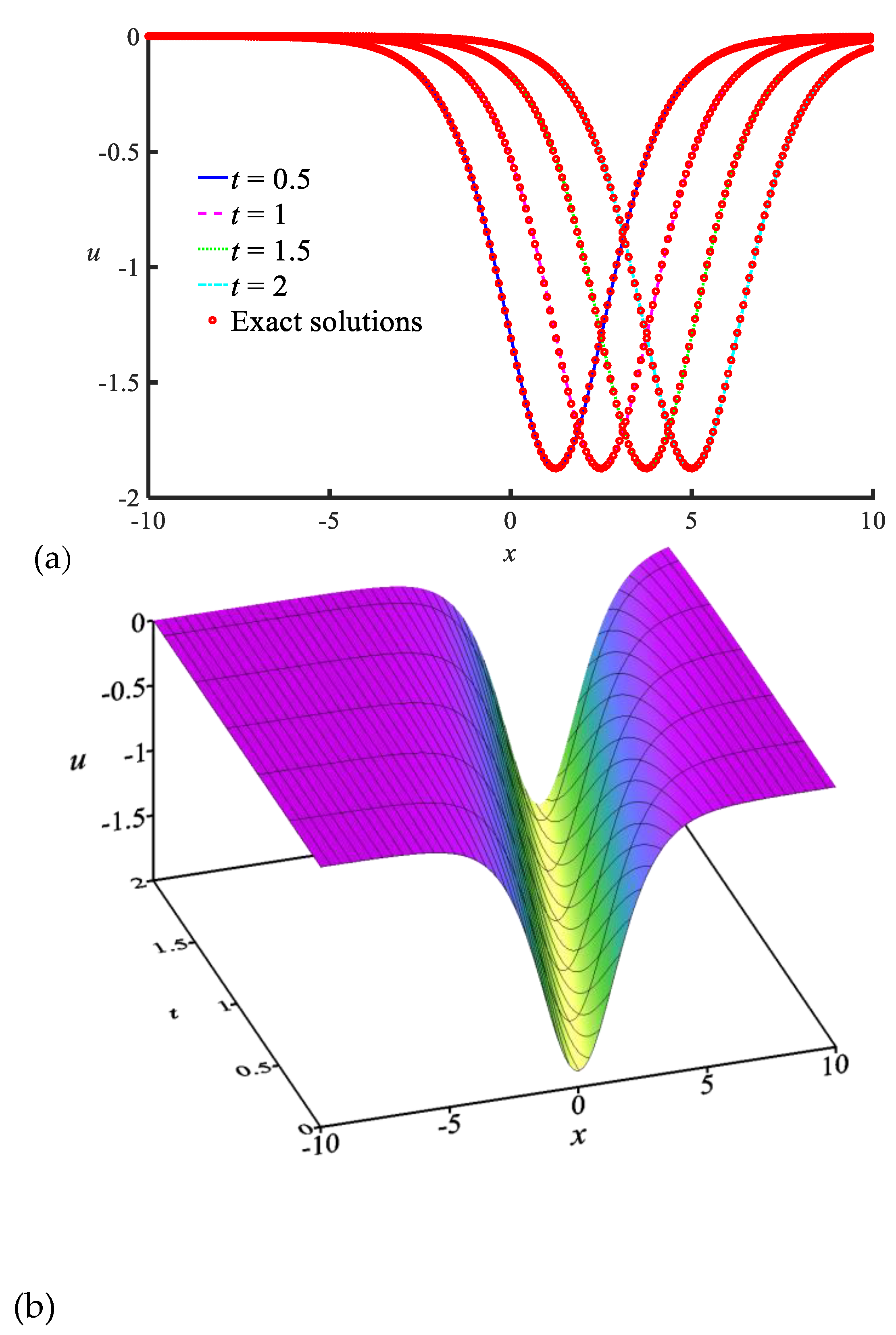1. Introduction
The dispersive shallow water wave is a kind of wave propagation phenomenon that has been widely studied in engineering. It has many applications in physics, engineering, mechanics, and mathematics. In the past few decades [
1,
2,
11,
3,
4,
5,
6,
7,
8,
9,
10], some partial differential equations (PDEs) have been presented to describe the traveling wave phenomenon, and most of these equations are nonlinear time-dependent PDEs such as the Camassa−Holm equation [
2,
3], the Degasperis−Procesi equation [
3,
8,
11], the Fornberg−Whitham equation [
1,
4,
5,
6,
7,
9,
10,
11], and their modified forms. Mathematically, the above-mentioned three equations and their modified forms are transient nonlinear PDE with third (3rd)-order time-space mixed partial derivatives. Therefore, how to obtain the numerical solutions of those PDEs is a significant issue for analyzing the traveling wave phenomenon. In previous studies, there were mainly two types of methods used to obtain solutions for such equations, which included the approximate method and numerical simulation.
To deal with such complicated equations, the exact solution is generally difficult to find, and the numerical ways are important numerical treatments for those equations. By using the numerical methods for temporal and spatial discretization, the classical numerical treatments were inconvenient to adopt due to the high-order mixed partial derivatives. Thus, the approximate methods for presenting the deriving the approximate numerical solutions were widely used by researchers. For example, Wazwaz [
3] used the extended tanh method to establish the new solitary wave solutions of the modified Degasperis−Procesi and Camassa−Holm equations. Abidi and Omrani [
4] applied the homotopy analysis method (HAM) to acquire the HAM results of the Fornberg−Whitham equation and compared it with Adomian’s decomposition method (ADM). Ahmad et al. [
10] utilized the modified variational iteration algorithm (MVIA) to get the approximate numerical solutions of the Fornberg−Whitham equation and its modified form. In addition to the above mentioned, there are other approximate methods such as the method of phase portraits analysis [
5], He’s variational iteration method (VIM) [
6], and the reproducing kernel Hilbert space method (RKHSM) [
7]. Recently, due to the evolution of computer technology and numerical methods, novel numerical schemes have also been applied to solve such equations such as the Godunov method [
9], the cubic B-spline quasi-interpolation method [
8], and the hybrid radial basis functions method [
11].
In the numerical discretization methods for PDEs, they can roughly divide into two families as mesh-based methods and meshless/free methods. The finite difference method (FDM), finite volume method, and finite element method are the famous mesh-based methods that are widely used. Those methods were developed and modified for solving the engineering problem and analyzed some physical phenomena that are difficult to obtain through practical experiments. Although these mesh-based methods are highly applied, mesh generation is still a troublesome issue today. Thus, the idea that using the numerical discretization methods without mesh becomes one of the important research directions. The meshless methods can avoid generating mesh, and make it easy to solve problems in a computational domain with complex shapes. In addition, the numerical discretization only needs to construct interpolation functions on arbitrary distribution nodes for the governing equation. After years of development, meshless methods have the advantages of simple numerical processes, easy programming, flexibility, and even the ability to construct a hybrid numerical scheme customized by researchers. At present, there are several meshless numerical methods, for example, the radial basis functions collocation method (RBFCM) [
11], the virtual boundary meshless Galerkin method [
12], the moving particle semi-implicit method [
13], the radial point interpolation meshless method [
14], the singular boundary method [
15], the localized scheme based on boundary-type method [
16,
17,
18], the generalized finite difference method (GFDM) [
19,
20,
29,
21,
22,
23,
24,
25,
26,
27,
28], etc.
The GFDM is a localized domain-type meshless collocation method based on the multivariate Taylor series expansion theory and the moving least-square method. In 1980, the idea that the FDM without mesh was proposed by Liszka and Orkisz [
19]. After Benito et al. [
20] proposed the explicit numerical process in 2001, numerical applications related to the GFDM have been proposed in the past two decades. By utilizing the GFDM, the approximate expression of the partial derivative terms can be represented by a linear combination of the weight coefficients and function values in a local support domain. This support domain only contains the goal node and its nearby nodes. Once the nodes are distributed in the computational domain, the governing equation can be discretized into a system of algebraic equations. In addition, the resultant matrix system is a sparse matrix due to the localized property of the GFDM. The above characteristics make the GFDM enable to apply for complex problems, such as the theoretical analysis [
29], shallow water equation [
21,
22], porous media flow [
23], wave propagation [
24], elliptic interface problems [
25], theoretical analysis, extended Fisher–Kolmogorov equation [
26], stream function formulation [
27], and elastic wave [
28]. In this research, the space-time GFDM (ST–GFDM) was applied as the foundation of the proposed meshless numerical scheme, and it is an extended meshless method from the GFDM.
The space-time (ST) coupled approach is a numerical technique that treated the temporal derivative as one of a spatial derivative. Before ST coupled approach was used, the original way to solve a time-dependent problem is that apply a numerical scheme that combines the spatial discretization method and temporal discretization method to solve. That caused the accuracy and stability of the numerical scheme to be hard to define. By utilizing the ST coupled approach, an (n)-dimensional time-dependent problem will transfer into an (n+1)-dimensional steady-state problem, then all of the partial derivatives in the governing equation can be discretized by the numerical method which applies for spatial discretization. Thus, the properties of the numerical scheme will much easier to determine. Recently, the ST coupled approach is widely combined with meshless methods such as the ST localized RBFCM [
30], ST kernel-based method [
31], ST localized method of fundamental solutions [
32,
33], ST Trefftz Method [
34,
35], ST backward substitution method [
36] and ST-GFDM [
37,
38,
39,
40,
41,
42,
43,
44,
45]. Based on the flexibility of the ST-GFDM, researchers applied this meshless method for engineering problems in the past few years, for example, the heat conduction problems [
37,
46], Burgers’ equations [
38], parabolic PDEs [
39], unsteady double-diffusive natural convection [
40], thin elastic plate bending problem [
41], thermoelasticity problems [
42], equal-width equation [
43], Zakharov–Kuznetsov-Modified equal-width equation [
44], and hyperbolic PDEs [
45], etc. The above achievements indicate that the ST-GFDM is one of the meshless method that have potential for engineering applications. In this research, the ST-GFDM is applied to combine with the two-step Newton’s method and time-marching approach for solving the dispersive shallow water wave problem.
After the motivation and the discussions of relevant works of literature are described in the first section. The governing equations of the dispersive shallow water wave are represented in
Section 2. In the section of proposed ST-GFDM, the numerical process is described and four numerical examples are simulated to verify the proposed method in section 4. Then, the conclusions are represented in the final section.
2. The Mathematical Models of the Dispersive Shallow Water Waves
The dispersive shallow water wave represents the behavior of the wave propagation, breaking wave, and dynamic system of the fluid. It is an important phenomenon in physics and engineering. In the past few decades, several researchers have proposed the mathematical model of the dispersive shallow water wave problem, and its general form of the governing equation [
1,
2,
3] is described as,
where
u is the wave speed;
x and
t are the spatial- and temporal- axis;
α,
β,
k, and
q are the constants. The initial conditions and boundary conditions are represented as,
By applying the constants,
a, b, k, and
q, three different type of the dispersive shallow water wave equation are defined. The first one is the Fornberg–Whitham equation [
1,
6,
7,
9,
10] that is given with
α=1,
β=1,
k=1, and
q=3 as,
and its modified form [
4,
7,
10] is given (
α=1,
β=1,
k=2, and
q=3) as,
The remaining two are similar; they are the Camassa–Holm equation [
2,
3] and Degasperis–Procesi equation [
3,
8,
11], respectively. By giving with
α=0,
β=3,
k=1, and
q=2, the Camassa–Holm equation can be denote as
and the Degasperis–Procesi equation (
α=0,
β = 4,
k = 0, and
q=3) is described as
As same to the relationship of the Fornberg–Whitham equation and its modified form, the modified form of the Camassa–Holm equation [
3] and Degasperis–Procesi equation [
3,
8,
11] are represented by changing nonlinear term
into
. Then, they can be described as follows,
and
Eqs. (1) and (3)-(7) are highly nonlinear PDEs and have 3rd-order mixed partial derivatives as . Its complexity caused the original explicit or implicit numerical schemes to be difficult to solve, and most of the researchers proposed approximate or exact solutions for dispersive shallow water wave equations. Therefore, the applications of the numerical scheme for such equations are still in the early stages of enlightenment. In this research, the Fornberg–Whitham equation and its modified form, modified Camassa–Holm equation, and modified Degasperis–Procesi equation are solved by the proposed ST-GFDM scheme. The numerical procedures of the proposed ST-GFDM scheme is introduced in the next section.
4. Numerical Examples
In this section, four numerical examples are tested to verify the proposed ST-GFDM, there are the examples of the Fornberg–Whitham equation and its modified form, modified Camassa–Holm equation, and modified Degasperis–Procesi equation, respectively. The following symbols are defined:
T is the end time of the numerical problem,
ND is the number of times that the ST domain has been moved by the time-marching method, and written as
. The distribution of nodes for each example is displayed in
Figure 1(a). To analyze the accuracy of the proposed ST-GFDM, the numerical errors are defined in this study as follows,
where superscript
ext is the exact solution;
num denotes numerical solutions. In Eq. (21),
is the maximum absolute errors (MAE) in Dn, and
is the maximum MAEs in the entire simulation. Meanwhile, root-mean-squared error (RMSE) in each ST domain is defined as RMSE
n in Eq. (22), and RMSE is the maximum RMSEs in the whole simulation. In addition, the initial guesses are the initial conditions of each numerical problem for iteration in D1, and the numerical solutions in Dn-1 are initial guesses of numerical processes in Dn.
4.1. Example 1
In this subsection, the Fornberg–Whitham equation [
1,
5] is solved. This mathematic model is presented to describe the behavior of the breaking wave and have the solitary or traveling wave solutions. The exact solution of the 1st numerical example is described as,
and the initial condition and boundary conditions are represented as,
The following parameters are applied in this numerical example:
a = -5,
b = 5, dt = 0.5,
T = 5, and
ND = 10. In
Figure 3, the numerical solutions are obtained by applying
NT = 8421 and
ns = 23. The numerical solutions in different time levels are compared with the exact solutions and demonstrated in
Figure 3(a). This figure shows that the numerical solutions have a good agreement with the exact solutions.
Figure 3(b) is a 3D surface plot of numerical solutions to observe the numerical behavior of the Fornberg–Whitham equation through time.
Table 1,
Table 2 and
Table 3 are presented to verify the accuracy and parameter sensitivity, MAEs and RMSEs are obtained by utilizing different numbers of
NT and
ns at different time levels. In
Table 1, the total number of nodes
NT is tested, and MAEs in different time levels are displayed. These error values indicate that more accurate numerical solutions will be obtained as
NT increases. Meanwhile, MAEs and RMSEs are also presented by using different
ns in
Table 2. These errors show that
ns is a parameter with low sensitivity. Furthermore, both tables demonstrate that there is no accumulation of errors during the numerical simulation, and numerically indicate that the ST approach can effectively avoid the accumulation of numerical error that a hybrid numerical scheme may encounter when apply to time-dependent problems.
In order to further validate the capability of the proposed numerical scheme, the numerical solutions locate at specific positions (
x,t) are presented in
Table 3, and compared with the exact solutions. In this table, the function values are taken to eight decimal places to show the precision accuracy of the proposed ST-GFDM. Besides, the proposed ST-GFDM is compared with the HAM [
4], ADM [
7], RKHSM [
7], and MVIA-I [
10], those comparisons are shown in
Table 3. In these comparative data, it can be seen that the proposed ST-GFDM performs better than the HAM and ADM. Although the accuracy is weaker than the RKHSM and MVIA-I, the solutions with numerical errors below 10
-6 or even 10
-7 can be obtained, which is already an acceptable numerical result for engineering applications. The above discussions show that the proposed ST-GFDM can accurately and stably solve the Fornberg–Whitham equation. Since the capability of the proposed ST-GFDM has been verified in this numerical example, the following numerical tests are solved by using specific parameters, and the obtained numerical results are compared with other approximation algorithms.
4.2. Example 2
The 2nd example is a numerical test for the modified Fornberg–Whitham equation [
5,
7,
9,
10,
11], the exact solution is given as follows,
where
. The initial condition and boundary conditions are denoted as,
The following parameters are used in this numerical example:
a = -10,
b = 10, dt = 0.2,
T = 1,
ND = 10,
NT = 40421 and
ns = 20. The numerical solutions are displayed in
Figure 4. In
Figure 4(a), the comparison of the exact solutions and the numerical solutions at specific time levels,
t=0.2, 0.4, 0.8, and 1, are shown, and these numerical results have a good agreement with the exact solutions. In addition, the MAEs at specific (
x,t) are listed in
Table 5 with the errors of the MVIA[
10] and VIM [
6]. Obviously, the error performance of the proposed numerical scheme is better than the other two approximation algorithms and also verifies that the proposed ST-GFDM is fully capable of handling such complex PDEs.
4.3. Example 3
The 3rd example is the modified Camassa-Holm equations [
2,
3], the exact solution is given as follows,
The follows are applied in this numerical example:
a = -10,
b = 10, dt = 0.5,
T = 2,
ND = 4,
NT = 37231 and
ns = 20. The initial condition and boundary conditions are gained by introducing the above parameters into Eq. (26). The numerical solutions are demonstrated in
Figure 5. In those plots, the obtained numerical results are compared well with the exact solution in
Figure 5(a), and the physical behavior of the wave transmission can be watched in
Figure 5(b). Meanwhile, the numerical results located at various locations are presented with the numerical results of the VIM [
3] in
Table 6. This table shows that the proposed ST-GFDM can successfully solve the Camassa-Holm equation, and can obtain accurate numerical solutions.
4.4. Example 4
The final example is the modified Degasperis−Procesi equation [
3,
11], the exact solution is given as follows,
boundary condition and initial condition can obtain from Eq. (27). The following parameters are used:
a = -10,
b = 10, dt = 0.5,
T = 2,
ND = 4,
NT = 37231 and
ns = 20. The numerical solutions and data are given in
Figure 5 and
Table 7, respectively. Due to the similarity of the modified Degasperis−Procesi equation and the modified Camassa-Holm equation, the behavior of the numerical solutions is similar as well. In those comparisons, the proposed ST-GFDM can obtain accurate numerical results as shown in the above numerical examples. As has been described above, the proposed ST-GFDM successfully solved the shallow water wave problem, and has the capable to stably simulate the long time scale problems.
5. Conclusions
In this research, the proposed ST-GFDM scheme is adopted for numerical solving the nonlinear shallow water wave equations in which, the modified Camassa−Holm equation, the modified Degasperis-Procesi equation, the Fornberg-Whitham equation, and its modified form. The ST-GFDM is proposed to discretize the governing equations in an ST domain, and the nonlinear algebraic system is solved by the two-step Newton’s method. By applying the ST-GFDM, mesh generation is avoided and makes the numerical processes simpler. On the other hand, the two-step Newton's method has the characteristic of second-order convergence, it correspondingly improves the efficiency for solving the problem that has a heavy computational burden in solving the inverse of a sparse matrix. To deal with long-time-scale numerical problems, the time-marching method is applied for moving the ST domain and saves the computational resource thereby addressing the shortcomings of the ST approach.
Four numerical examples are presented to verify the proposed ST-GFDM scheme. By changing different parameters in the first numerical case, it can be concluded that increasing the total number of nodes can obtain more accurate numerical solutions. Meanwhile, the tests in adjusting ns in a supporting domain verify that ns is an insensitive parameter. The numerical solutions have good agreements with exact solutions and the solutions of other approximation methods in four examples. Besides, the accumulation of numerical errors is not significant during the process of time progression, indicating that the proposed ST-GFDM scheme has a strong advantage for solving transient problems. In the future, it can be applied to solve more complex PDEs and engineering problems.











